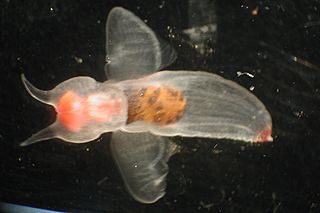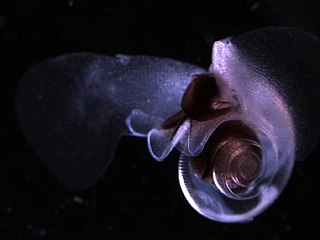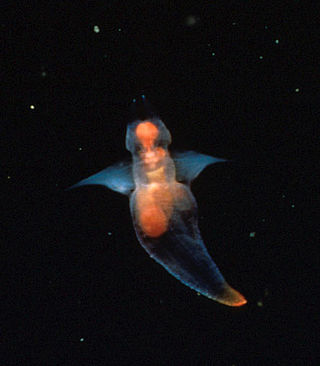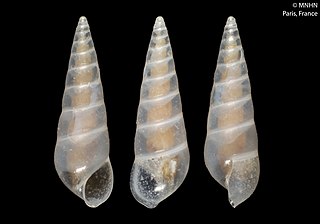
Sea angels are a large group of small free-swimming sea slugs, classified into six separate families. They are pelagic opisthobranchs in the clade Gymnosomata within the larger mollusc clade Heterobranchia. Sea angels were previously considered to be pteropods.

The Limacinidae are a family of small sea snails, pteropods, pelagic marine gastropod mollusks in the clade Thecosomata.

Limacina is a genus of swimming predatory sea snails commonly known as sea butterflies in the family Limacinidae. This genus contains some of the world's most abundant gastropod species.

Cymbuliidae is a family of pelagic sea snails or "sea butterflies", marine gastropod mollusks in the superfamily Cymbulioidea.

The Clionidae are a family of sea angels, which are a group of pelagic marine gastropods.

Tiberia is a genus of minute parasitic sea snails, marine gastropod molluscs in the family Pyramidellidae, the pyrams and their allies. Tiberia is the only genus in the tribe Tiberiini.

Amathinidae, is a taxonomic family mostly consisting of small and minute sea snails, marine heterobranch gastropod molluscs or micromolluscs in the superfamily Pyramidelloidea.
Tjaernoeia is a genus of sea snails, marine gastropod mollusks in the informal group Lower Heterobranchia.

Clione limacina, known as the naked sea butterfly, sea angel, and common clione, is a sea angel found from the surface to greater than 500 m (1,600 ft) depth. It lives in the Arctic Ocean and cold regions of the North Atlantic Ocean. It was first described by Friderich Martens in 1676 and became the first gymnosomatous "pteropod" to be described.
Paradoris indecora is a species of sea slug, a dorid nudibranch, shell-less marine gastropod mollusks in the family Discodorididae.

Anekes is a genus of sea snails, marine gastropod mollusks, unassigned in the superfamily Seguenzioidea.

Titiscania is a genus of slug-like sea snails, shell-less marine gastropod mollusks in the superfamily Neritopsoidea.

Obtusella is a genus of minute sea snails, marine gastropod mollusks or micromollusks in the family Rissoidae.

Limacina helicina is a species of small swimming planktonic sea snail, in the family Limacinidae. It belongs to the group commonly known as sea butterflies (Thecosomata).
Clione antarctica is a species of "sea angel", a sea slug, a pelagic marine gastropod mollusk in the family Clionidae, the "sea angels".
The family Cliidae is a taxonomic group of small floating sea snails, pelagic marine opisthobranch gastropod molluscs.

The genus Clio is a taxonomic group of small floating sea snails, pelagic marine opisthobranch gastropod mollusks, the sole genus belonging to the family Cliidae

Eulima anonyma is a species of sea snail, a marine gastropod mollusk in the family Eulimidae. The species is one of a number within the genus Eulima.
Clione okhotensis is a species of sea angel, a pelagic marine gastropod in the family Clionidae.
Clione elegantissima is a species of sea angel in the family Clionidae.












